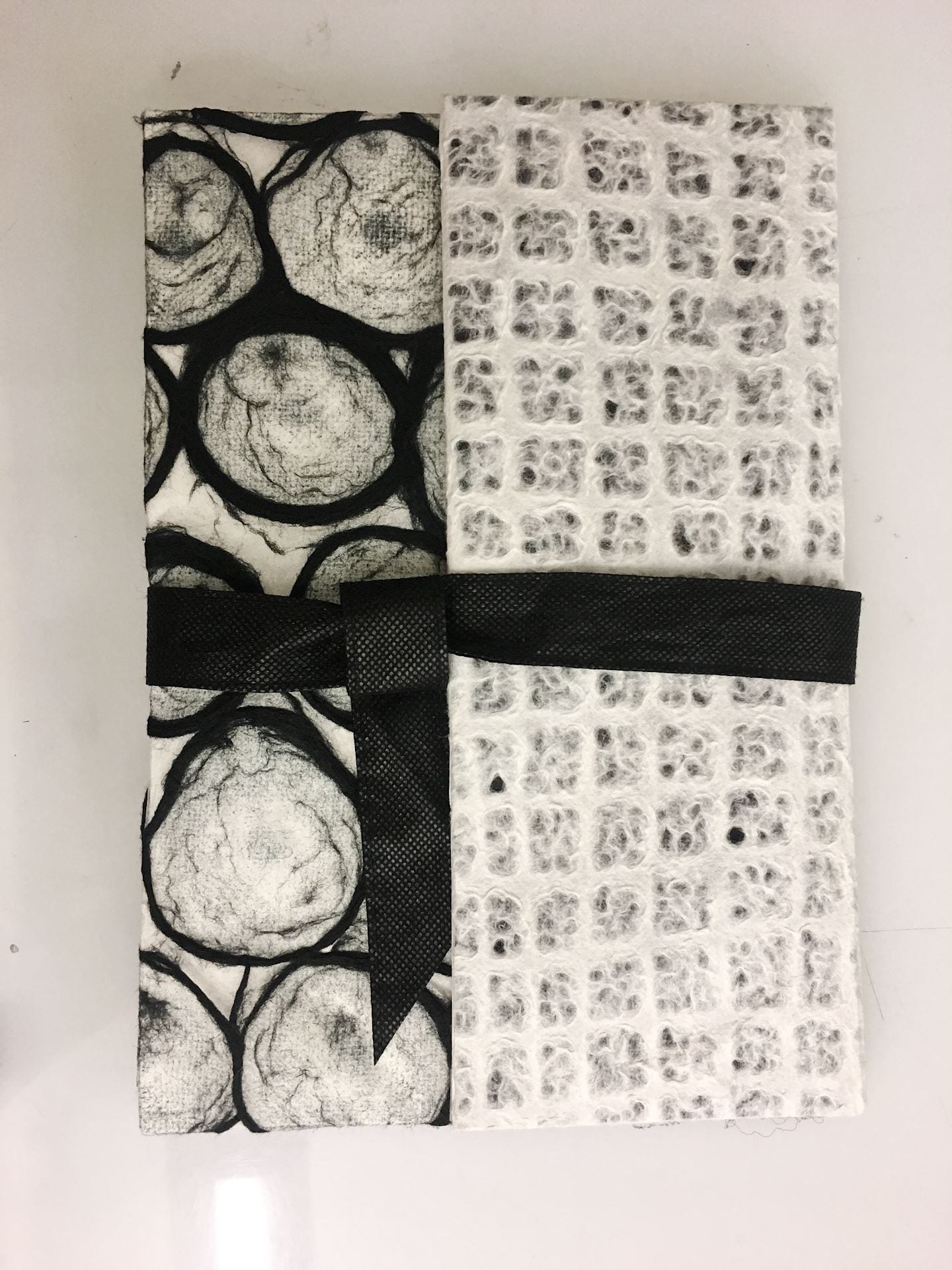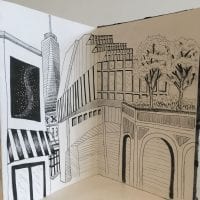Overview:
I chose the Meatpacking District as my New York location to explore. I decided to focus my project on the complex and interesting history of the district, as this small two acre region has experienced some of the most massive cultural shifts in New York City. I wanted to show the viewer’s of my book how, despite the drastic shifts in culture and various “incarnations” the Meatpacking District has gone through in the centuries, the waterside district still retains parts of its past as it moves forward through time. The title of my book, “The Name Remains The Same” references this idea that, although the areas purpose has changed and transformed multiple times, its name still carries a piece of the areas history.
I began construction by folding a long portion of paper into an accordion shape and started to sketching different “ages” of the Meatpacking District history, making sure sure to emphasize certain architecture and structures that could help the viewer see the passage of time simply through visuals. I decided to make the interior drawings of the book solely in pen and ink because I was inspired by the archival black and white photography of the area. In the first “panels”, one can see the meatpacking factories that overtook the area in the nineteenth century, the old railroad line that transported the meat out of New York, and the Gansevoort Market; a marketplace that still remains today. Moving forward in the book, the next set of panels showcases the Meatpacking District during its “commercial phase”, when luxury hotels, exclusive nightclubs, and expensive boutiques and restaurants began springing up in the area. In this panel, one can also notice that some of the old buildings are starting to be refurbished and renovated for the use of new stores and restaurants. Although the function of the structures change drastically, the buildings still retain their character, charm, and history. The final panel represents the most modern incarnation of the Meatpacking District; today, the area is considered a cultural hub for art, food, and fashion as well as a one of many waterside districts undergoing massive restoration and preservation of original and historical architecture and landmarks. My book can be viewed multiple ways: first, by opening as one would a traditional book and flipping through the “decades”. Secondly, by completely opening the book up so it becomes a continuous timeline. Lastly, by standing the book upright and viewing it at an angle forwards or backwards, from these angles parts of the panels line up and allows the viewer to look forwards or backwards in time. Next I began construction of the cover; I wanted the book to feel similar to an artists journal, since it would be filled with hand done drawings, while also relating to the style of the interior. I decided to use black and white handmade paper as it fit with both the color scheme and also the overall aesthetic of the book. One cover panel is a contrasting white paper on black background, the pattern is geometric and complements the architecture and linework inside the book, while offering a nice contrast from the circular patterned main cover panel that lays on a white background. The addition of the strap keeps the book tidy and together while also adding a small touch that makes the book feel more like an artist’s personal journal.
My writing portion of the book focuses on bringing the reader briefly through each of the different cultural shifts that swept through the Meatpacking District, giving them the history and context needed to understand the illustrations on the inside. It also highlights the main idea of my book throughout, referencing how the area retains its past and proudly carries its history with it throughtime. The positioning of my writing is also important as I wanted to give the reader all the necessary information needed for them to understand the amount of change the district has gone through all at once in the beginning of the book, because I wanted the interior to be free of text and speak for itself.
General Artist’s Statement Script:
When an author writes a novel, they often remark that they are simply writing for an audience of one: themselves. They don’t allow their minds to wander off the page, to what others may think when they write. They simply write.
When I create a piece of art, I find myself doing the exact opposite. Art holds so much potential, so much power, that I find it necessary to put myself in the shoes of my audience. I want to know, to experience, the different thoughts that drift into their minds when they see my work. Art is subjective, there is no question about that. You and I may lay our eyes on the same piece, yet interpret it in a thousand different ways. What makes you feel as though that stroke of paint represents rage, when another, may see joy? The only part of my art I can try to control is the amount of emotion it exudes and evokes in a viewer.
I find my art often revolves around nature, a subject I find personally very evocative. The presence of nature has always been in a constant in my life, growing up surrounded by woods on all sides. Since I was young, I was fascinated with the diversity found in nature, it has a natural beauty no man can ever recreate, yet, it serves as a constant source of inspiration for many, including myself. When it comes to creating my art, I often find myself gravitating towards generally delicate mediums. I love the fluidity of watercolor, the playful freedom that comes with working with charcoal, and the simple mark making achieved by pen and ink. Like my mediums, my art is often delicate. I prefer a more minimalist palette in my work, making complex designs from many simple beautiful strokes. I constantly find myself leaning towards the color white in my art. Pure and simple, the absence of color can sometimes speak louder than 10 colors combined.
Final Project Photographs:
- Front Cover
- Back Cover
- Back Cover (cont.
- Title Page
- Inner Text
- Book in Traditional “Page” Layout (Section 1)
- Book in Traditional “Page” Layout (Section 2)
- Book in Traditional “Page” Layout (Section 3)
- Book in Freestanding Acordian Layout (Section 1)
- Book in Freestanding Acordian Layout (Section 2)
- Book in Freestanding Acordian Layout (Section 3)
- Looking “Forwards” Through Time
- Looking “Backwards” Through Time
Detail Photographs:
Written Portion:
“Contained within only two acres on Manhattan’s west side lies New York City’s Meatpacking District. Despite its small size, the historic neighborhood has bore witness to some of the most profound transformations and cultural shifts in all of New York City.
The neighborhood takes its name from the massive meatpacking industry that developed in the area in the late nineteenth century, resulting in the creation of 250 slaughter houses and packing plants. The Meatpacking District quickly became a bustling industrial area that became one of the nation’s largest meat suppliers. Slowly, however, the area saw a decline.
During the mid 1900s many of New York’s waterfront districts became derelict; the once busy factories and packing plants of the Meatpacking District sat rotting and abandoned. As time passed, the dilapidated district became the epicenter for a new type of “industry”; nightlife for gay clientele. Throughout the 1970s and 80s, nightclubs for gay and trans communities sprung up and drug use skyrocketed.
As the district entered the late 1990s, the area slowly began its current, more mainstream resurgence. The neighborhood’s culture shifted once again as the area became a popular spot for freethinkers and artists. The original architecture of the district was restored and refurbished; factories that once sat derelict were now being transformed into stylish boutiques, renowned restaurants, and trendy nightclubs. Soon, the once abandoned district became a cultural hub for food, fashion and art. The restoration of the waterside districts, the Meatpacking District in particular, focused on both the preservation of the areas historical integrity while also repurposing the original structures for modern use.
Within the last decade, massive redevelopment has been underway to refurbish the waterside districts. One of the largest projects was the Highline, a retired elevated freight railroad, used to transport meat during the district’s industrial hayday, that was transformed into an public park spanning two miles.
The Meatpacking District has experienced countless cultural shifts since its founding in the early nineteenth century: developing from an industrial wasteland to a upmarket cultural hub. Through each transition, the neighborhood has been given new life, yet still stays true to its heritage as a part of New York City’s industrial past. Though the Meatpacking District’s purpose has constantly shifted throughout the years,
the name remains the same.”
Goldstein, Barry. “Small Hours in the Meatpacking District.” Gastronomica 11, no. 4 (2011): 23-25. doi:10.1525/gfc.2012.11.4.23.
“History.” Meatpacking District Official Website. Accessed April 1, 2019.
RABINOWITZ, RICHARD. “A City Visible to Itself.” In Bending the Future: Fifty Ideas for the Next Fifty Years of Historic Preservation in the United States, edited by Page Max and Miller Marla R., 205-09. Amherst; Boston: University of Massachusetts Press, 2016.



























